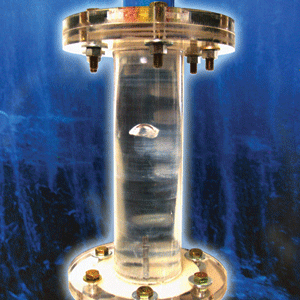
Most current urban water systems were designed and built in the first half of the 20th century and are ill-prepared to cope with the impacts of climate change, population growth and ecosystem demands. On top of that, the infrastructure is deteriorating.
That’s the opinion of a team of researchers at Mines who? have joined forces with colleagues at Stanford University, the University of California at Berkeley and New Mexico State University to form the NSF-funded Engineering Research Center for Re-Inventing the Nation’s Urban Water Infrastructure (ReNUWIt).
Supported by a $20 million grant, the ERC will work to develop new technologies, educate policy makers and the public, and evaluate water systems that integrate traditional and new technologies with natural processes and environments.
Water management systems don’t make use of current technologies, says Tzahi Cath, assistant professor of environmental science and engineering and director for Mines’ Advanced Water Technology Center (AQWATEC). “Everything flows in and out of centralized treatment plants across large networks of sewers and pipes. That uses quite a bit of energy,” he says. “We purify most of our water to a high quality, but then use it for things like washing cars or flushing toilets. There is a lot of inefficiency.”
Such inefficiency is increasingly hard to afford in an era of aging infrastructure, tight public works budgets and changing climates, all of which affect water supply. Smarter, more efficient water systems are desperately needed, and Mines is a key partner in the NSF’s single largest initiative to address the issue.
“Ideally, we’d be able to tweak our systems so that you can produce water of different qualities for different reuse applications,” explains Cath, an approach they refer to as tailored water reuse. Such an approach makes the most sense in decentralized treatment systems, where water is treated and reused without moving it long distances. Just such a system is already operating on campus at Mines Park, where a membrane bioreactor reclaims 7,000 gallons of wastewater a day and is capable of purifying it to 10 times the clarity of drinking water standards.
The beauty of the system is that you can also dial it back. The idea is to cleanse only to the quality needed for the intended use, which saves energy and money. Water for cooling towers doesn’t need to be as clean as agricultural irrigation water, which doesn’t need to be as clean as the water running to our kitchen sinks. “There are many applications where you don’t need to meet the highest quality standards,” Cath explains.
However, public health regulations don’t yet permit water treated by facilities like the one at Mines Park to be used for multiple purposes. So one of the goals of the ERC is to challenge such policies. “We’re looking at a system-level approach and long-term impacts,” says J�rg Drewes, the ERC’s research director and a professor of environmental science and engineering at Mines. “This includes technology, policy, social perception and economic issues.”
As they prepare for the years of research ahead, developing ways to measure the costs of different water systems is an important priority. These new metrics will gauge a broad range of factors, including water usage, finance, energy, carbon footprint, pollution and maintenance. To evaluate a range of different systems and approaches, we first need to have a basis for comparison, says Cath.
They will also be looking at how to generate potential revenue streams. Cath points to a line on a graph indicating the nitrogen levels of water coming out of the bioreactor at Mines Park over a two-week period. The line is relatively flat for several days, and then climbs to a much higher concentration, where it flattens out. “We made a small adjustment to the operating conditions inside the bioreactor and deliberately increased the nitrogen content of the treated water,” says Cath. Nitrogen is an important fertilizer, so the ERC will be looking at the economics of using this resource in, say, urban landscapes. Another option the ERC will be investigating is converting nitrate into an energy resource such as nitrous oxide.
While there is a lot of hypothesizing at this point, the NSF wants practical engineered solutions from the ERC, and the team at Mines is keenly focused on delivering. “We want to be a game-changer,” says Drewes. “We want new ideas that are actually implemented in practice. This has never been funded in the past, so the world’s environmental engineering community is watching us. It’s a tremendous opportunity for us, and for our students. I believe we have a chance to educate a generation of global leaders.”



